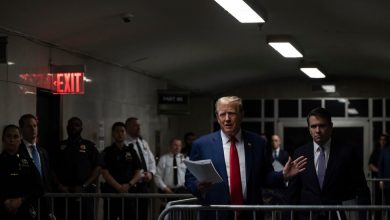Giant Pandas Are Returning to San Diego, China Announces

The United States and China may be at odds these days over Russia’s war in Ukraine, cheap Chinese exports, tensions with Taiwan and matters of human rights.
But when it comes to giant pandas, diplomacy is back.
The Ministry of Foreign Affairs in China confirmed this week that two giant pandas — Yun Chuan and Xin Bao — would be sent from the China Conservation and Research Center to the San Diego Zoo. The zoo has a longstanding partnership with China on panda conservation research, and a ministry spokesman said the upcoming exchange would focus on prevention and treatment of major diseases and habitat protection.
“We believe as China-U.S. cooperation in this area deepens, it will enhance the capacity for cooperation and research on endangered wildlife and biodiversity conservation and contribute to the conservation of endangered wildlife and the friendship between Chinese and Americans,” the spokesman, Lin Jian, said.
It is not clear when the new pandas will arrive, but the agreement should allay concerns that the recent tensions between the United States and China would threaten the beloved tradition of panda diplomacy.
China has been lending the bears to American zoos for more than five decades as a friendly gesture between the two countries. But with the United States returning most of its pandas to China over the past several years, many admirers had worried that the practice could be ending.
In November, two adult pandas, Mei Xiang and Tian Tian, and their 3-year-old cub, Xiao Qi Ji, were driven in trucks from the National Zoo in Washington and then flown back to China on a FedEx Boeing 777 called the Panda Express. The San Diego Zoo sent its last pandas back in 2019. Last April, the Memphis Zoo returned its female giant panda, Ya Ya.
Leaders of the San Diego Zoo Wildlife Alliance’s conservation team recently traveled to China to meet with the pandas. Yun Chuan is a nearly 5-year-old male whose mother was born in the San Diego Zoo in 2007. Xin Bao, a nearly 4-year-old female, was born in Wolong Shenshuping Panda Base in Sichuan Province and, according to the conservation alliance, is known to be a “gentle and witty introvert.”
“Our partnership over the decades has served as a powerful example of how, when we work together, we can achieve what was once thought to be impossible,” said Dr. Megan Owen, the vice president of conservation science at San Diego Zoo Wildlife Alliance. “We have a shared goal of creating a sustainable future for giant pandas.”
The announcement follows recent efforts among top Biden administration officials to steady the U.S. relationship with China.
In April, Treasury Secretary Janet L. Yellen and Secretary of State Antony J. Blinken made separate trips to China, where they expressed concern about issues such as China’s recent surge in green energy exports and human rights violations in the Xinjiang region.
Experts in the relationship between the United States and China expressed appreciation for the pandas’ symbolism but noted that many weightier issues still required more progress.
Eswar Prasad, the former head of the International Monetary Fund’s China division, expressed hope that the collaboration on panda conservation could lead to more cooperation on areas such as climate change.
“A pair of pandas, cute and fluffy though they might be, will not by themselves do much to ease China-U.S. tensions,” said Mr. Prasad, who is also a Cornell University professor. “Still, it is certainly a healthy portent if the two sides can continue cooperation on issues where they have common objectives while keeping those separate from issues on which they have deep-rooted conflicts.”
And while China’s pandas have been granted passage to San Diego, flights for American and Chinese travelers remain limited.
“I am glad that the U.S. and China can find a way to cooperate on or exchange really anything,” said Meg Rithmire, a Harvard Business School professor who specializes in the comparative political economy of development with a focus on China. “I’d like to see more visas and visits for humans, too.”




